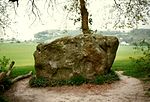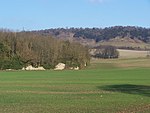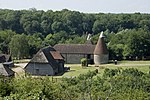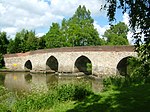Smythe's Megalith, also known as the Warren Farm Chamber, was a chambered long barrow east of Blue Bell Hill, north of Maidstone, in the south-eastern English county of Kent, close to Aylesford village and the hamlet of Sandling.
Probably constructed in the 4th millennium BCE, during Britain's Early Neolithic period, it was discovered in 1822, at which point it was dismantled. Built out of earth and at least five local sarsen megaliths, the long barrow consisted of a roughly rectangular earthen tumulus with a stone chamber in its eastern end. Human remains were deposited into this chamber.
Archaeologists have established that the monument was built by pastoralist communities shortly after the introduction of agriculture to Britain from continental Europe. Although representing part of an architectural tradition of long barrow building widespread across Neolithic Europe, Smythe's Megalith belonged to a localised regional variant produced in the vicinity of the River Medway, now known as the Medway Megaliths.
Several of the Medway Megaliths still survive: Coldrum Long Barrow, Addington Long Barrow, and Chestnuts Long Barrow are on the river's western side, while Kit's Coty House, the Little Kit's Coty House, and the Coffin Stone are on the eastern side nearer to Smythe's Megalith. Close to the site of the lost monument is the White Horse Stone, a standing stone that may have once been part of another chambered long barrow.
The site may have been ransacked during the Middle Ages, as other Medway Megaliths were. By the early 19th century it was buried beneath soil, largely due to millennia of hillwash coming down from the adjacent Blue Bell Hill. In 1822, it was discovered by farm labourers ploughing the land; the local antiquarians Clement Smythe and Thomas Charles were called in to examine it. Shortly after, the labourers pulled away the stones and dispersed most of the human remains, destroying the monument. Smythe and Charles produced, but did not publish, reports on their findings, and these have been discussed by archaeologists since the mid-20th century.











